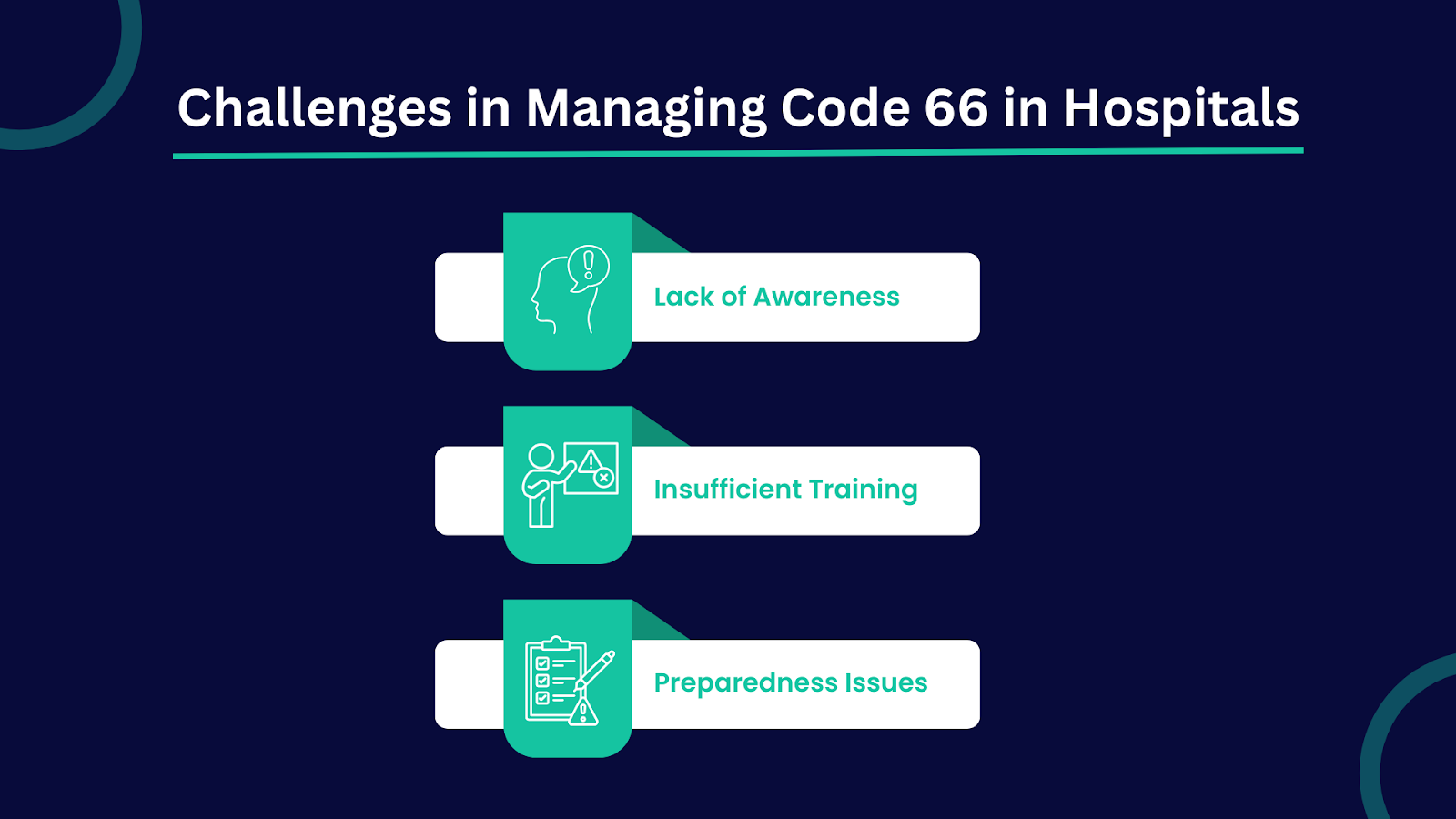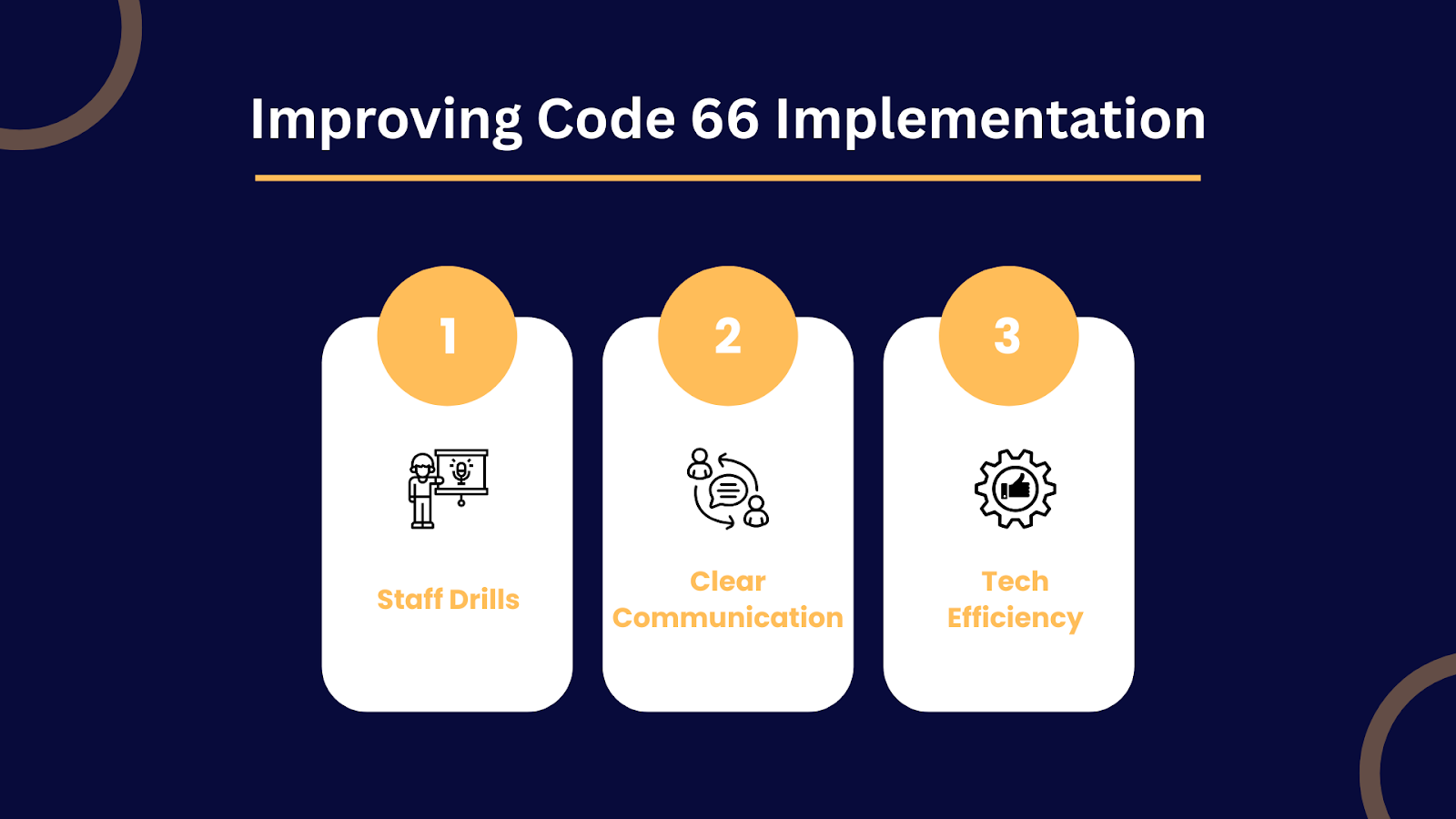In hospital emergencies, time is critical to patient outcomes, yet you may still struggle with delays. For example, in 2022, approximately 3 million emergency department visits that resulted in hospital admissions involved waits of four hours or more before patients were transferred to inpatient care. This highlights a significant gap in response times that affects both patient care and operational efficiency
Code 66 is an emergency protocol designed to streamline responses in critical situations, particularly in emergency departments (EDs). While the goal is clear, which is rapid and coordinated action, the execution often falls short of this goal. . What factors contribute to these delays, and how can you improve performance? Let’s explore what Code 66 is and its role in hospital operations.
What is Code 66?
Code 66 is a hospital emergency protocol that typically signals a critical incident within the hospital, specifically triggering actions to streamline or manage operational issues, such as patient safety concerns or urgent staffing requirements. In some hospitals, Code 66 is associated with scenarios that involve major operational disruptions, particularly within emergency departments (EDS).
Code 66 is defined differently by each institution. While some hospitals use it to identify situations requiring immediate attention due to system failures or sudden staffing shortages, others may associate it with more specific guidelines or regional regulations. For instance, in some US hospitals, Code 66 can be activated during a surge in patient volume, a disaster event, or even a situation where patient care needs overwhelm the hospital’s resources.
For example, imagine a situation where your emergency department (ED) faces a sudden surge in trauma patients due to a significant accident. The hospital might activate Code 66 to mobilize additional resources, such as staffing, equipment, and operational support, ensuring that care is provided as efficiently as possible.
Also Read: What is Medical Coding? A Comprehensive Guide
Having covered the basics, let’s now examine the specific circumstances that trigger Code 66 and why hospitals apply this protocol in urgent situations.
When and Why is Code 66 Applied?
Code 66 is often applied when you face overwhelming or urgent situations that require quick, coordinated action. Some of the most common situations where Code 66 might be triggered include:
- Surge in Patient Volume: When patient intake exceeds the hospital’s capacity, typically due to mass casualties, epidemics, or other emergencies.
- System Failures or Operational Disruptions: When a significant technical failure occurs, such as an electronic health record (EHR) outage or power failure, that hinders the hospital’s ability to function normally.
- Staffing Shortages: When unexpected staff absences (e.g., due to illness or emergencies) require the immediate reallocation of resources to maintain care standards.
Why Is Code 66 Used?
Hospitals use Code 66 to prevent compromises to patient safety, meet legal and regulatory requirements, and ensure operational continuity during critical moments. It enables hospital staff to swiftly address urgent concerns, prioritise patient care, and minimise delays in treatment or diagnosis. In some instances, such protocols help hospitals comply with specific emergency response regulations, ensuring they can meet both state and federal healthcare standards.
Now that you know when and why Code 66 is applied, it’s time to compare it with other hospital emergency codes to see how it uniquely addresses operational crises.
Code 66: Understanding Its Specific Use
So, what exactly does Code 66 address, and how does it differ from other hospital codes? Let’s break it down.
Code 66 typically targets operational or resource-related crises. It is fundamentally different from Code Blue (medical emergency) or Code Red (fire emergency), which are used for specific medical or life-threatening situations. Instead, Code 66 focuses on urgent operational needs, like addressing sudden surges in patient numbers or managing critical equipment shortages.
Comparison with Other Emergency Codes:
- Code Blue: Activated when there is a medical emergency requiring immediate attention, typically related to a cardiac arrest or respiratory failure.
- Code Red: Activated during a fire emergency or when there is a fire hazard in the hospital.
- Code 66: Focuses on operational crises like resource shortages or sudden increases in patient volume.
While Code Blue and Code Red are more clinical in nature, you use Code 66 to manage hospital systems and ensure smooth operations during critical periods. This difference makes it a vital tool for administrators and staff to address logistics rather than clinical care directly.
With a solid grasp of Code 66’s purpose, let’s turn our focus to its impact on hospital operations, from patient care to staff roles and system adjustments.
Implications of Code 66 on Hospital Operations
The activation of Code 66 carries both direct and indirect implications for hospital operations. These impacts can range from changes in patient care delivery to significant adjustments in staffing, resource allocation, and compliance.
Impact on Patient Care:
During a Code 66 event, hospitals often face disruptions in regular care procedures. However, the protocol aims to maintain patient safety and prevent delays in treatment. Immediate steps include prioritising urgent cases and ensuring your hospital is sufficiently staffed to handle the situation.
Impact on Staff Roles:
Staff members will be tasked with additional duties during a Code 66 situation. These may include reallocating clinical resources, assisting with patient triage, and helping with other operational tasks to ensure you meet the surge in demand. This change in staff duties is necessary to manage the sudden surge and stabilize the situation.
Operational Changes:
Hospitals often enact temporary shifts in protocols when Code 66 is triggered. For example, administrative staff may be tasked with tracking resources or managing patient admissions to prevent bottlenecks. You might also prioritize discharges for patients who are stable, opening up space for incoming emergency cases. Moreover, hospitals may experience significant operational changes, including:
- Shift reorganization for hospital staff.
- Resource prioritization (e.g., equipment or ICU beds).
- Temporary relocation of patients to alternate departments.
Ultimately, the goal is to maintain your hospital’s capacity to operate effectively while ensuring optimal patient care.
Challenges Faced by Hospitals in Managing Code 66
Hospitals face significant challenges when managing Code 66, especially in high-stress environments where rapid, coordinated responses are crucial. These obstacles can lead to delays and complications during emergencies, affecting both patient care and operational efficiency.

1. Lack of Awareness
In some hospitals, staff may not be fully aware of the specific procedures for activating and responding to Code 66. This knowledge gap can lead to confusion, mistakes, and delayed responses in critical situations, worsening the patient’s condition.
2. Insufficient Training
Without consistent and rigorous training, emergency responses can be slow and ineffective. Your hospital staff, including frontline medical professionals and support teams, must undergo regular training and simulation drills to ensure they act swiftly and correctly when Code 66 is triggered. Inadequate preparation can result in fragmented responses, jeopardizing patient care.
3. Preparedness Issues
While many hospitals have Code 66 protocols, the lack of proper preparedness, such as clearly defined roles, clear communication channels, and resource management strategies, often leads to chaos. A well-organised response plan is essential for mobilizing the right resources quickly, but without it, your hospital may struggle to maintain control during high-pressure situations.
These challenges can severely impact patient care, leading to worsened outcomes, increased staff stress, and overwhelmed facilities. It’s essential to address both the operational challenges and the ethical concerns associated with delayed or inconsistent emergency responses. Let’s explore it!
Practical Challenges and Ethical Considerations
The effectiveness and acceptance of Code 66 often depend on how well it is implemented across the hospital. While the protocol is designed to streamline emergency responses, it may not always be effective if not consistently applied.
Effectiveness of Code 66
For Code 66 to be effective, it must be adopted across all departments. When the protocol is inconsistently applied or poorly communicated, its value diminishes, resulting in disjointed responses and slower recovery times.
Ethical Implications of Response Delays
Delays in responding to emergencies can raise serious ethical concerns. You must balance the urgency of the situation with the resources at your disposal. While rapid action under Code 66 can save lives, delays in response can raise questions about whether healthcare providers failed to meet their duty to act promptly.
To enhance the success of Code 66, hospitals can take several steps to improve implementation and address ethical concerns, which leads us to practical strategies and recommendations for refining the protocol.
Recommendations for Improving Code 66 Implementation
Hospitals can refine their response to Code 66 by focusing on a few key areas to overcome challenges and improve preparedness:
1. Regular Staff Training and Simulation Drills
Regular training is essential to ensuring your staff knows exactly how to respond when Code 66 is activated. Simulating emergency scenarios helps your staff stay prepared for high-pressure situations, reducing confusion and increasing the speed of response.
2. Clear Communication Protocols
Establishing well-defined communication protocols is crucial for ensuring that all staff members can act swiftly and efficiently during a Code 66 event. You must develop easy-to-follow communication strategies to minimize delays and improve coordination among departments.
3. Leveraging Technology for Efficiency
Technology plays a crucial role in improving response times and decision-making during emergencies. ProMantra, a trusted provider of healthcare solutions, offers advanced analytics and workflow management software to help hospitals streamline their emergency response. With ProMantra’s real-time tracking systems, your hospital can ensure that resources are allocated effectively and critical data is accessible to staff without delay.
By integrating ProMantra’s solutions, your hospital can enhance operational efficiency, reduce response times, and improve patient outcomes, all while ensuring compliance with necessary protocols.
While improving implementation is crucial, adopting best practices can further ensure that hospitals are ready to respond efficiently when emergencies arise.
Best Practices for Handling Code 66 in Hospitals
To ensure the best outcomes during Code 66 activation, your hospital should adopt the following best practices:

1. Comprehensive Staff Training and Preparedness
Ongoing education and realistic emergency drills are essential for ensuring that your hospital teams know how to respond to Code 66 effectively. Having a well-prepared team is key to a swift and coordinated response.
2. Effective Communication Across Departments
Clear and standardized communication systems allow your hospital staff to relay critical information quickly and efficiently. You should invest in communication tools that support fast, real-time interactions during emergencies.
3. Utilizing Technology for Better Coordination
Technology can enhance the speed and accuracy of emergency responses. ProMantra healthcare management software integrates real-time data, automating task allocation and helping teams mobilize the right resources quickly. With ProMantra, your hospital can streamline workflows, reduce administrative burdens, and ensure the best possible care for patients during emergencies.
Conclusion
Effectively managing Code 66 is key to ensuring positive patient outcomes and operational efficiency during emergencies. By addressing challenges in awareness, training, and preparedness, your hospital can improve response times and coordination.
Leveraging technology like ProMantra integrated healthcare solutions optimizes emergency management, reduces delays, and enhances staff coordination. ProMantra tools provide real-time tracking and data-driven insights, crucial for handling Code 66 effectively.
To improve your hospital’s emergency response and optimise operational efficiency, explore ProMantra’s integrated healthcare solutions today.
Contact us for a demo and see how we can help streamline your Code 66 management.




